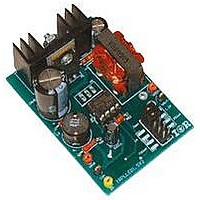IRPLLED1 International Rectifier, IRPLLED1 Datasheet - Page 6

IRPLLED1
Manufacturer Part Number
IRPLLED1
Description
BOARD EVALUATION FOR IRS2540PBF
Manufacturer
International Rectifier
Specifications of IRPLLED1
Current - Output / Channel
1.5A
Outputs And Type
1, Non-Isolated
Voltage - Output
24V
Features
Dimmable
Voltage - Input
50 ~ 170V
Utilized Ic / Part
IRS2540PBF
Core Chip
IRS2540, IRS2541, IRS25401
Topology
Buck (Step Down)
No. Of Outputs
1
Output Current
1.5A
Output Voltage
500mV
Dimming Control Type
PWM
Development Tool Type
Hardware - Eval/Demo Board
Lead Free Status / RoHS Status
Contains lead / RoHS compliant by exemption
The frequency in the IRS2540/1 application is free running and maintains current regulation by quickly adapting to
changes in input and output voltages. There is no need for additional external components to set the frequency as
seen with most oscillators. The frequency is determined by L1 and COUT, as well as the input/output voltages and
load current. The selection of the frequency is a trade-off between system efficiency, current control regulation, size,
and cost.
The higher the frequency, the smaller and lower the cost of L1 and COUT, the higher the ripple, the higher the FET
switching losses, which becomes the driving factor as VBUS increases to higher voltages, the higher the component
stresses and the harder it is to control the output current.
With an input voltage as high as 170V, the targeted frequency was determined to be between 50kHz and 75kHz.
Within these operating conditions all components can withstand their associated power losses.
To maintain tight hysteretic current regulation L1 and COUT need to be large enough to maintain the supply to the
load during t_HO_on and avoid significant undershooting of the load current, which in turn causes the average
current to fall below the desired value.
First, we are going to look at the effect of the inductor when there is no output capacitor to clearly demonstrate the
impact of the inductor. In this case, the load current is identical to the inductor current. Fig. 7 shows how the
inductor value impacts the frequency over a range of input voltages. As can be seen, the input voltage has a great
impact on the frequency and the inductor value has the greatest impact at reducing the frequency for smaller input
voltages.
Fig. 8 shows how the variation in load current increases over a span of input voltage, as the inductance is decreased.
Fig. 9 shows the variation of frequency over different output voltages and different inductance values. Finally Fig.
10 shows how the load current variation increases with lower inductance over a range of output voltages.
www.irf.com
3. Frequency selection
4. Output L1 and COUT selection
1600
1400
1200
1000
800
600
400
200
0
10
Fig. 6 Vbus = 100V, L1 = 470uH, COUT = 33uF
15
RD-0608
Vout (V)
20
25
±0.1%
±0.17%
±0.13%
±0.25%
350mA
700mA
1A
1.5A
30
6











